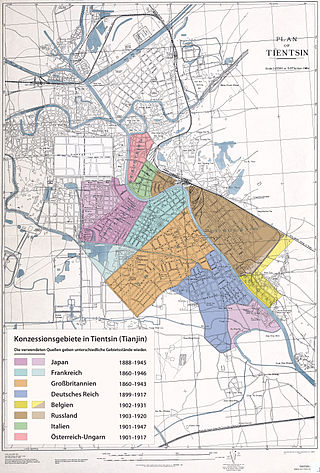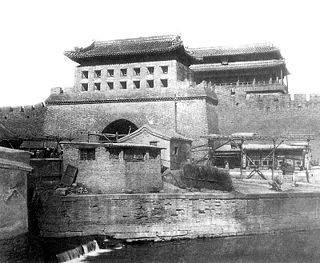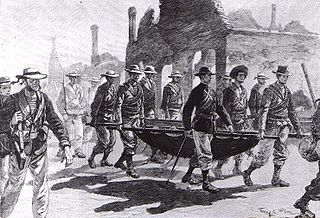
Tianjin is a municipality and metropolis in Northern China on the shore of the Bohai Sea. As such, it is not part of a province of China. It is one of the nine national central cities in Mainland China, with a total population of 13,866,009 inhabitants at the time of the 2020 Chinese census. Its metropolitan area, which is made up of 12 central districts, was home to 11,165,706 inhabitants and is also the world's 29th-largest agglomeration and 11th-most populous city proper.

The Boxer Rebellion, also known as the Boxer Uprising, the Boxer Insurrection, or the Yihetuan Movement, was an anti-foreign, anti-imperialist, and anti-Christian uprising in North China between 1899 and 1901, towards the end of the Qing dynasty, by the Society of Righteous and Harmonious Fists, a group known as the "Boxers" in English due to many of its members having practised Chinese martial arts, which at the time were referred to as "Chinese boxing". It was defeated by the Eight-Nation Alliance of foreign powers.

The Treaty of Tientsin, also known as the Treaty of Tianjin, is a collective name for several unequal treaties signed at Tianjin in June 1858. The Qing dynasty, Russian Empire, Second French Empire, United Kingdom, and the United States were the parties involved. These treaties, counted by the Chinese among the so-called unequal treaties, opened more Chinese ports to foreign trade, permitted foreign legations in the Chinese capital Beijing, allowed Christian missionary activity, and effectively legalized the import of opium. They ended the first phase of the Second Opium War, which had begun in 1856 and were ratified by the Emperor of China in the Convention of Peking in 1860, after the end of the war.

The Eight-Nation Alliance was a multinational military coalition that invaded northern China in 1900 during the Boxer Rebellion, with the stated aim of relieving the foreign legations in Beijing, which was being besieged by the popular Boxer militiamen, who were determined to remove foreign imperialism in China. The allied forces consisted of about 45,000 troops from the eight nations of Germany, Japan, Russia, Britain, France, the United States, Italy, and Austria-Hungary. Neither the Chinese nor the quasi-concerted foreign allies issued a formal declaration of war.
In international relations, a concession is a "synallagmatic act by which a State transfers the exercise of rights or functions proper to itself to a foreign private test which, in turn, participates in the performance of public functions and thus gains a privileged position vis-a-vis other private law subjects within the jurisdiction of the State concerned." International concessions are not defined in international law and do not generally fall under it. Rather, they are governed by the municipal law of the conceding state. There may, however, be a law of succession for such concessions, whereby the concession is continued even when the conceding state ceases to exist.

The foreign concessions in Tianjin were concession territories ceded by Qing China to a number of European countries, the United States and Japan within the city of Tianjin. There were altogether nine foreign concessions in old Tianjin on the eve of World War II. These concessions also contributed to the rapid development of Tianjin from the early to mid-20th century. The first foreign concessions in Tianjin were granted in 1860. By 1943, all the foreign concessions, except the Japanese concession, had ceased to exist de facto.

Foreign concessions in China were a group of concessions that existed during the late Imperial China and the Republic of China, which were governed and occupied by foreign powers, and are frequently associated with colonialism and imperialism.

The Peking Legation Quarter was the area in Beijing (Peking), China where a number of foreign legations were located between 1861 and 1959. In the Chinese language, the area is known as Dong Jiaomin Xiang, which is the name of the hutong through the area. It is located in the Dongcheng District, immediately to the east of Tiananmen Square.

Yongdingmen, was the former front gate of the outer city of Beijing's old city wall. Originally built in 1553 during Ming Dynasty, it was torn down in the 1950s to make way for the new road system in Beijing. In 2005, the Yongdingmen was reconstructed at the site of the old city gate. This new gate is disconnected from the original road leading towards the gate and into the city.

The Battle of Tientsin, or the Relief of Tientsin, occurred on 13–14 July 1900, during the Boxer Rebellion in Northern China. A multinational military force, representing the Eight-Nation Alliance, rescued a besieged population of foreign nationals in the city of Tianjin by defeating the Chinese Imperial army and Boxers. The capture of Tianjin gave the Eight-Nation Alliance a base to launch a rescue mission for the foreign nationals besieged in the Legation Quarter of Beijing and to capture Beijing.

The Gansu Braves or Gansu Army was a unit of 10,000 Chinese Muslim troops from the northwestern province of Kansu (Gansu) in the last decades of the Qing dynasty (1644–1912). Loyal to the Qing, the Braves were recruited in 1895 to suppress a Muslim revolt in Gansu. Under the command of General Dong Fuxiang (1839–1908), they were transferred to the Beijing metropolitan area in 1898, where they officially became the Rear Division of the Wuwei Corps, a modern army that protected the imperial capital. The Gansu Army included Hui Muslims, Salar Muslims, Dongxiang Muslims, and Bonan Muslims.

The Sino-British Treaty for the Relinquishment of Extra-Territorial Rights in China, or the Sino-British New Equal Treaty, was a bilateral treaty concluded between the British and the Chinese government in Chongqing on 11 January 1943. The formal name of the treaty was Treaty Between His Majesty in Respect of the United Kingdom and India and His Excellency the President of the National Government of the Republic of China for the Relinquishment of Extra-Territorial Rights in China and the Regulation of Related Matters.

The Seymour Expedition was an attempt by a multi-national military force to march to Beijing and relieve the Siege of the Legations and foreign nationals from attacks by Qing China's government troops and the Boxers in 1900. The Chinese army and Boxer fighters defeated the Seymour armies and forced them to return to Tianjin (Tientsin). It was followed later in the summer by the successful Gaselee Expedition.
The Gaselee Expedition was a successful relief by a multi-national military force to march to Beijing and protect the diplomatic legations and foreign nationals in the city from attacks in 1900. The expedition was part of the war of the Boxer Rebellion.

The Italian concession of Tianjin was a small territory (concession) in central Tianjin, China, controlled by the Kingdom of Italy between 1901 and 1943, officially ceded to China in 1947.

Zhang Xueming was a Chinese soldier and politician. He served as the mayor of Tianjin in 1931, during the Japanese invasion of Manchuria, before being forced into exile. After the Second World War, Zhang defected from the Kuomintang and joined the Communist forces during the Chinese Civil War.
The Banca Italo-Cinese established in 1919, later dissolved and renamed Banca Italiana per la Cina in 1925, was the most important Italian financial intermediary in Asia until the outbreak of World War Two. The history of the bank is significantly intertwined with the development of the Sino-Italian political relations during the interwar period.

The Kulangsu International Settlement was an international settlement in China on the Kulangsu or Gulangyu Island of Xiamen, Fujian province. During the Opium Wars, the British army occupied Gulangyu Island for four years and did not withdraw until 1845. After 1843, Xiamen was opened as a treaty port in accordance with the Sino-British Nanjing Treaty. The United Kingdom also acquired a beach on the coast of Xiamen's main island to build a British concession, while Gulangyu retained its original features. Over time, more nations established embassies as the settlement prospered.

The American concession of Tianjin was a territory (concession) in the Chinese city of Tientsin de facto occupied by the United States between the 1860s and 1901 in present-day Xiaobailou Subdistrict. American administration of the settlement existed in a legal gray area where no material paperwork ever existed to demarcate the concession, and its existence was only made possible by acknowledgement by all sides: the United States, the Qing dynasty, and other local concession municipal governments, including the German, Russian, and British concessions.

The Italian Expeditionary Corps in China was an expeditionary force the Kingdom of Italy sent to China in the summer of 1900 to assist in the efforts of the Eight-Nation Alliance to put down the Boxer Rebellion. It began to return to Italy in 1901, but some of its elements operated in China until 1905. The Italian participation in the campaign against the Boxers allowed Italy to obtain the Italian concession of Tientsin in 1901.





















